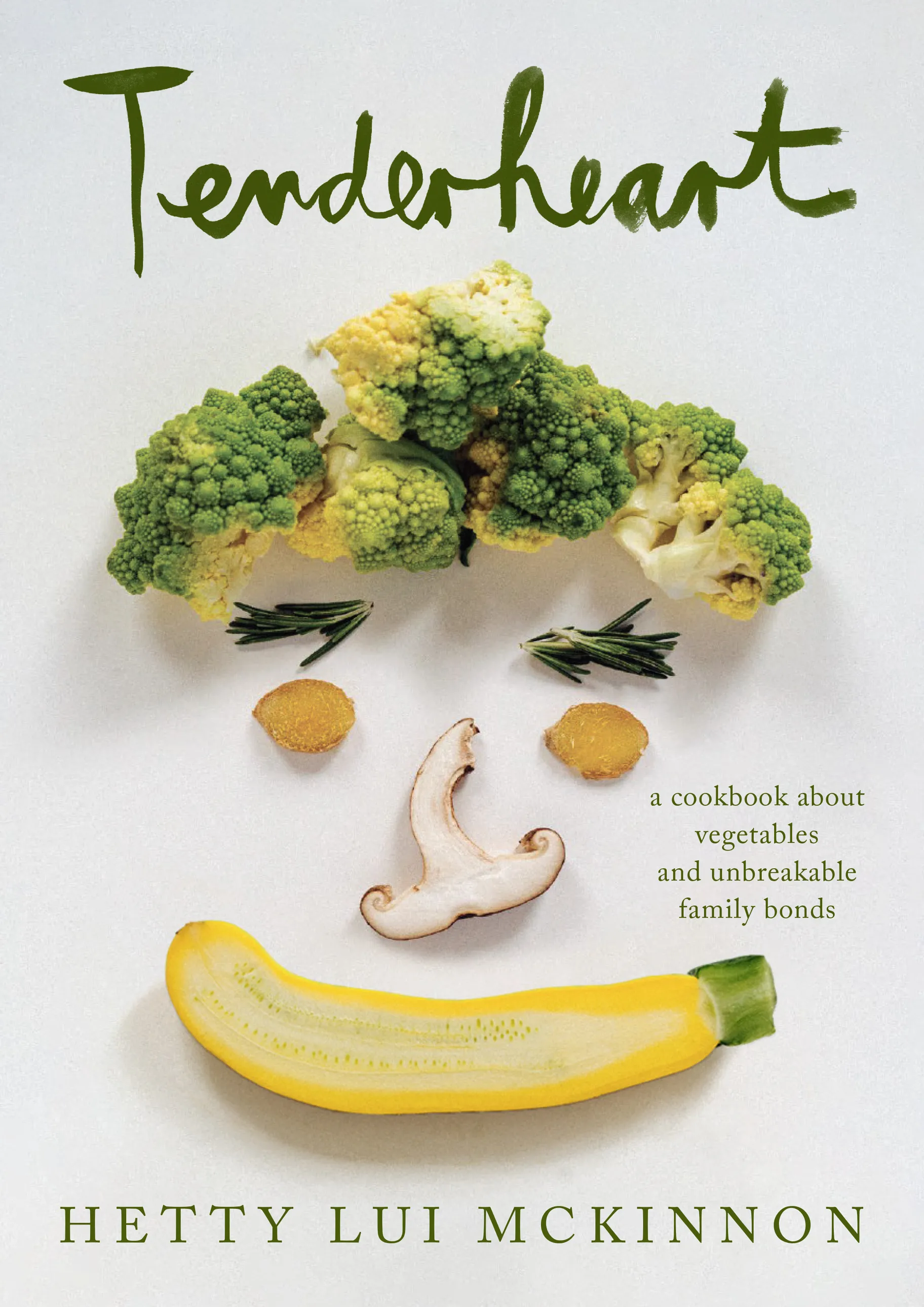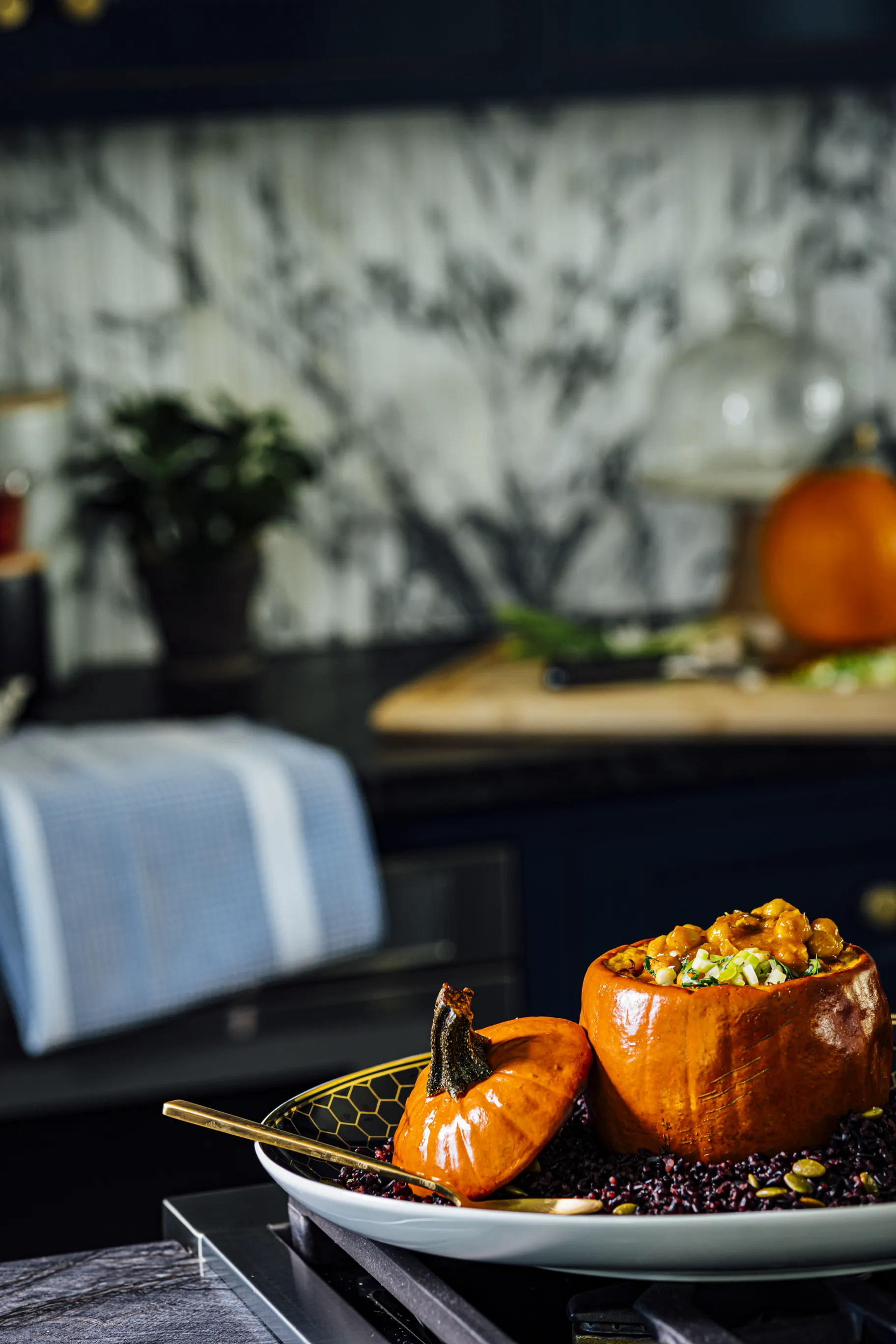Hetty Lui McKinnon grew up in Australia with her Chinese parents. She recalls attempting a traditional feast her first two Thanksgivings in the U.S. Her husband roasted a turkey that got a lackluster reception but was more popular the next day as a pot pie.
With a father in the produce business, McKinnon has led a vegetable-forward life. She has served green beans and Brussels sprouts for the holiday and calls sweet potato casserole a "crime against food."
Hazelnut Hasselback Potato Gratin
Serves 4
Potatoes are essential to our holiday and celebration table, and for the past few years, this has been our chosen dish. This rich vegan gratin is perfumed with leeks and rosemary, and smothered in a velvety hazelnut cream. While you can use store-bought hazelnut milk, I always make my own (see Notes below for instructions)—I like the pronounced nuttiness of homemade hazelnut milk, which delivers a creamy béchamel-like sauce that is still light. Use the whole leek, including the green leaves that many recipes ask you to discard—these are slightly tougher than the tender whites, but this dish cooks in the oven for over an hour, plenty of time for them to soften.
Ingredients
- 3 tablespoons (42 g) regular or vegan butter
- 3 tablespoons (30 g) rice flour or all-purpose flour
- 3 cups plus 2 tablespoons (750 ml) hazelnut milk (see Note)
- 1 garlic clove, finely chopped
- pinch of freshly grated nutmeg
- 1 sprig of rosemary, leaves picked and finely chopped
- 1 tablespoon soy sauce or tamari
- sea salt and black pepper
- 1 leek, white and green parts finely sliced and washed well
- extra-virgin olive oil
- 3 pounds 5 ounces (1.5 kg) potatoes (any variety), scrubbed
- 15–20 sage leaves
Instructions
-
Preheat the oven to 350°F (180°C). You’ll need an ovenproof dish— I use an 8 ½-inch (22 cm) square baking dish, but you can size slightly up or down.
-
Heat a saucepan over medium heat and melt the butter. Gradually add the flour, a tablespoon at a time, whisking constantly to prevent burning or clumps. When well combined with the melted butter, add the hazelnut milk and 1 cup (240 ml) of water and whisk constantly for 2–3 minutes, until creamy and slightly thicker (you want the consistency of heavy cream). Whisk in the garlic, nutmeg, rosemary, soy sauce or tamari and season well with sea salt and black pepper. Remove from the heat and set aside.
-
Place the leek in the ovenproof dish, drizzle with some olive oil, season with sea salt and black pepper and toss. Press the leek into an even layer, then add ½ cup (120 ml) of the hazelnut cream and smooth it out with the back of a spoon.
-
Next, finely slice the potatoes using a mandoline or sharp knife (a mandoline makes this job so much easier and quicker). As you are slicing, try to keep the potatoes in a neat stack. Arrange the stacks of potato in the dish, edge-side up, until the dish is full. I usually like to place the stacks in an alternating crisscross pattern, but you can simply line them up across the dish or in a circular pattern—it’s up to you. The potato should be tightly packed.
-
Pour the remaining hazelnut cream over the potatoes, drizzle with olive oil and season with sea salt and black pepper. Place the dish on a sheet pan to catch any drips, then cover with foil and bake for 1 hour. Meanwhile, place the sage leaves in a small bowl, drizzle with olive oil and season with a pinch of salt.
-
After 1 hour, remove the foil from the potato and scatter on the sage. Increase the oven temperature to 420°F (230°C) and bake for another 15–20 minutes, until the potatoes are golden and bubbling, and the sage leaves are crispy.
-
Serve with a green salad or steamed veggies.
"I've always looked at vegetables as mains," says McKinnon. Her vegan hazelnut potato gratin is featured in her latest cookbook, Tenderheart: A Cookbook About Vegetables and Unbreakable Family Bonds. "Hazelnuts have an intensely earthy flavor," she says. She uses them to make a cream that she layers with the sliced tubers. Alternatively, a butternut squash lasagna replaces pasta with vegetables for another hearty centerpiece dish.

Hetty Lui McKinnon confronts the loss of her father and her love of produce in "Tenderheart: A Cookbook About Vegetables and Unbreakable Family Bonds." Photo courtesy of Knopf.
"I'm a big fan of stuffing vegetables and rolling leaves, as people will find," says Nik Sharma. He shares a recipe for a roasted whole head of cauliflower and sugar pie pumpkins filled with chana masala. The chickpeas are cooked in a sauce made from onions, tomato paste, and spices. It's a Thanksgiving surprise when cut open over a bed of black, forbidden rice.

Sugar pie pumpkins are stuffed and roasted with chana masala. Photo by Nik Sharma.
Chana Masala Pumpkin Pots
Makes 4
Orange and black! Visually, everything about this dish screams Halloween to me and I even considered carving these little pumpkin pots into jack-o’-lanterns. In this recipe, roasted sugar pie pumpkins are filled with chana masala and then served over a bed of warm forbidden rice. For Thanksgiving or any fall dinner, this makes a delicious and seasonally spectacular entrée.
Ingredients and Instructions
-
To prepare the chana masala, in a large saucepan or Dutch oven, warm 2 Tbsp extra-virgin olive oil or ghee over medium-high heat. Add 2 large yellow or white onions, thinly sliced, and sauté until they turn translucent, 4 to 7 minutes. Add 2 garlic cloves, minced; 1 Tbsp peeled and grated fresh ginger; 1 tsp garam masala, homemade (page 341) or store-bought; 1 tsp whole cumin seeds; and ½ tsp ground turmeric and cook until fragrant, 30 to 45 seconds. Add ¼ cup [60 g] tomato paste and cook until the tomato paste starts to brown, 2 to 3 minutes, lowering the heat as necessary to avoid scorching. Fold in two 14 oz [400 g] cans chickpeas, rinsed and drained, and 1 cup [240 ml] water and heat until the chickpeas are warmed through.
-
Using an immersion blender, pulse for a few seconds to break up some of the chickpeas. This will help thicken the liquid. Don’t overdo this, but if you end up making it too thick, stir in ½ cup [120 ml] water. Stir in 1 Tbsp lemon juice and scrape the bottom of the pot to incorporate any browned bits that remain. Taste and season with fine sea salt.
-
Preheat the oven to 400°F [200°C]. Cut about 1 in [2.5 cm] of the top of 2 small sugar pie pumpkins (each about 2 lb [910 g]) to form a lid. Core and remove the seeds (see Roasted Pumpkin Seeds, page 187) and stringy materials (freeze and use to make vegetable stock, page 337). Brush the inside of the pumpkin and the tops with 2 Tbsp extra-virgin olive oil and sprinkle with fine sea salt. Place the pumpkins and their lids, cut side up, on a rimmed baking sheet or roasting pan and roast until the flesh is tender and easily pierced by a skewer or fork and golden brown, 40 to 50 minutes. Remove from the oven.
-
While the pumpkins roast, cook the rice. In a medium saucepan, bring 1 cup [100 g] black or forbidden rice, rinsed and drained; 2½ cups [600 ml] water; and fine sea salt to a boil over medium-high heat. Turn down the heat to low and simmer, covered, until all the water is absorbed and the grains are tender, 40 to 50 minutes. Remove from the heat and let rest, covered, for 15 minutes.
-
To serve, transfer the rice to a serving plate. Carefully transfer the pumpkins on top of the rice (be careful, they will be very delicate once roasted and can easily collapse; a sturdy slotted fish spatula will be your friend here). Divide the chana masala between the two pumpkins. Garnish the chana masala with a few sprigs of cilantro and 2 scallions, both white and green parts, thinly sliced. Top the rice with 2 Tbsp toasted salted pumpkin seeds.
-
Serve immediately with a carving knife and a large serving spoon. Leftovers can be stored in an airtight container in the refrigerator for up to 3 days
McKinnon suggests a salad with fruit to cut through the richness of the holiday meal. Sharma imagines a radish salad, with a floral dressing being the star of the dish.
